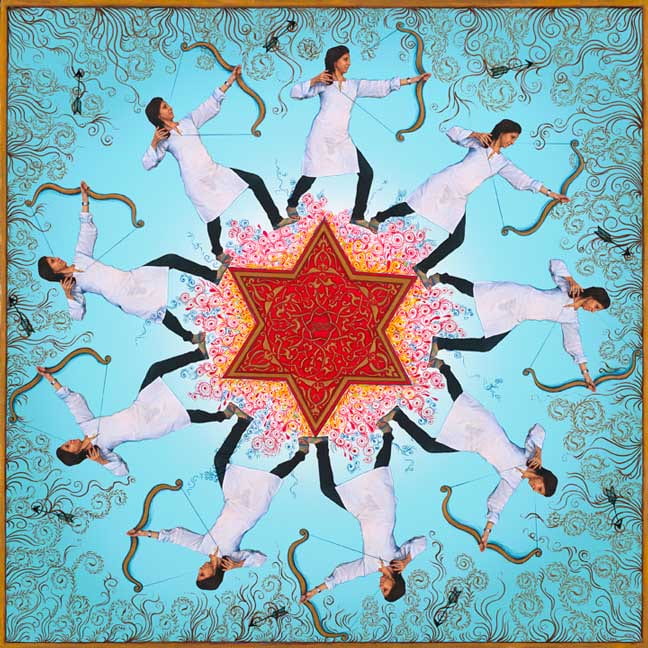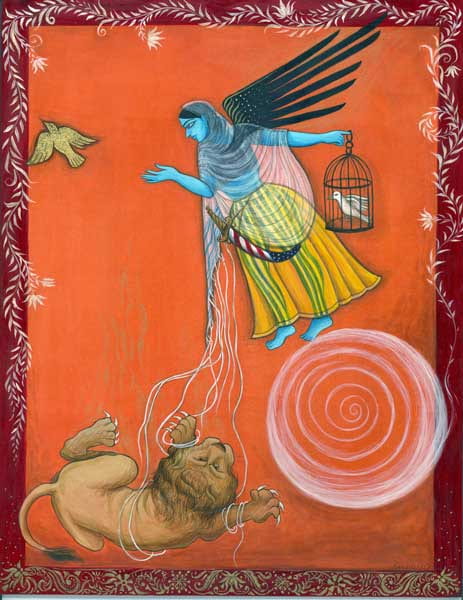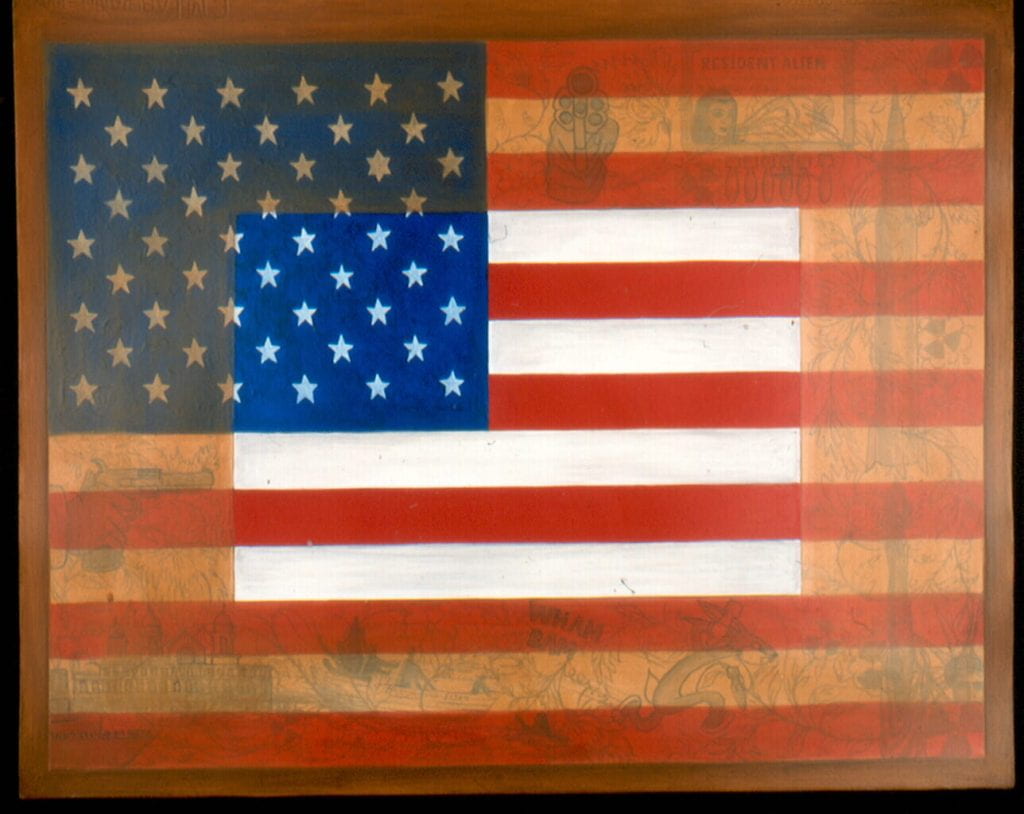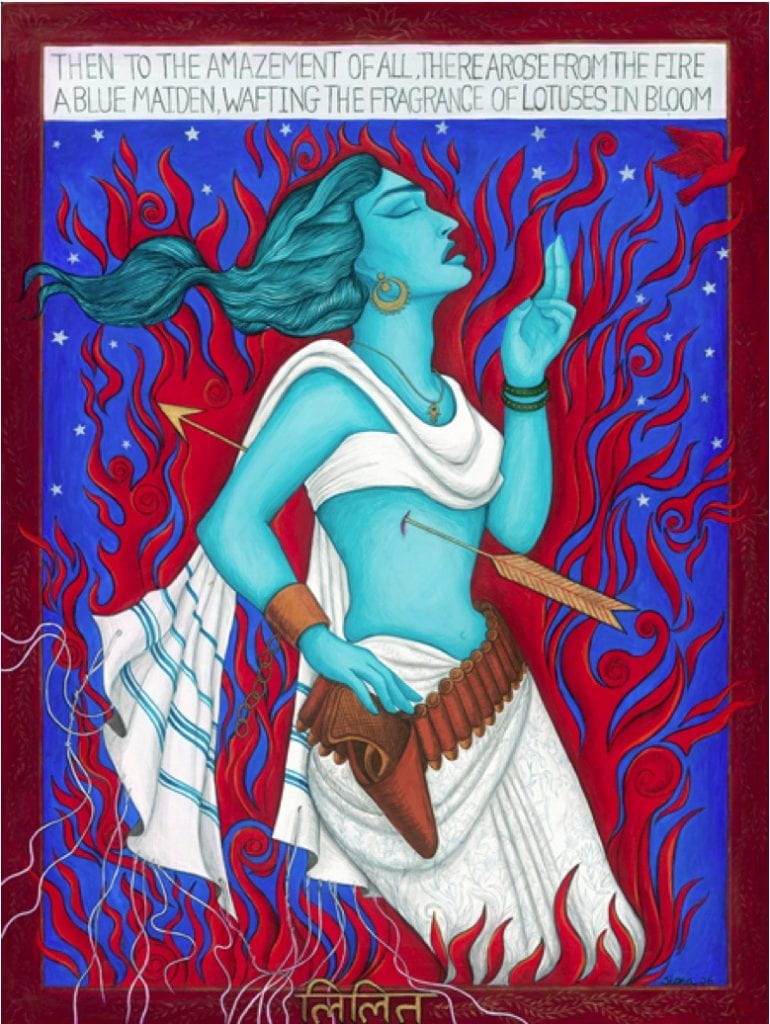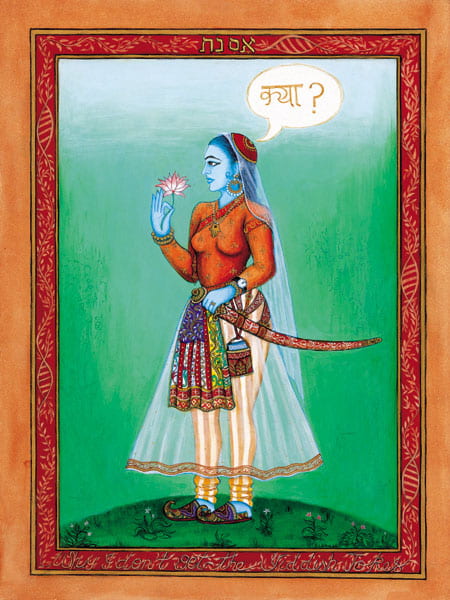Jonathan Gambrell
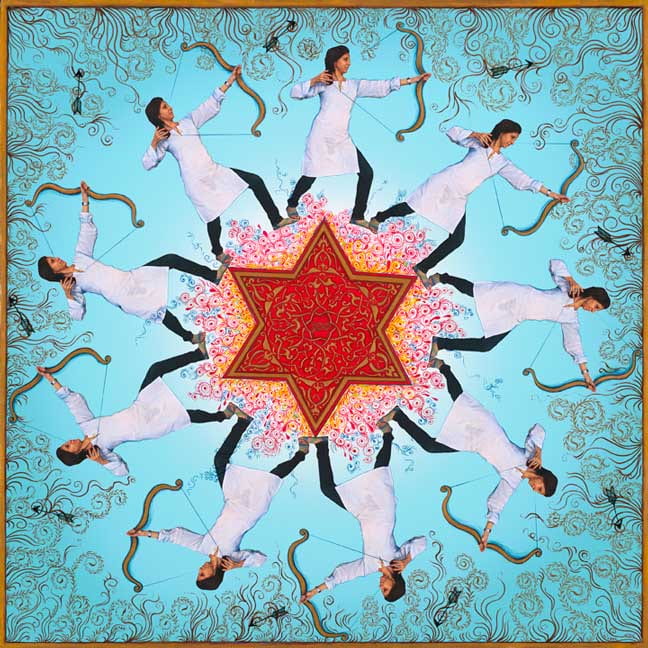
FullBright Series #5 Eddna Samuel (Akshikar) Photo Collages with Gouache and Acrylic Paint on Hahnemuhle Paper 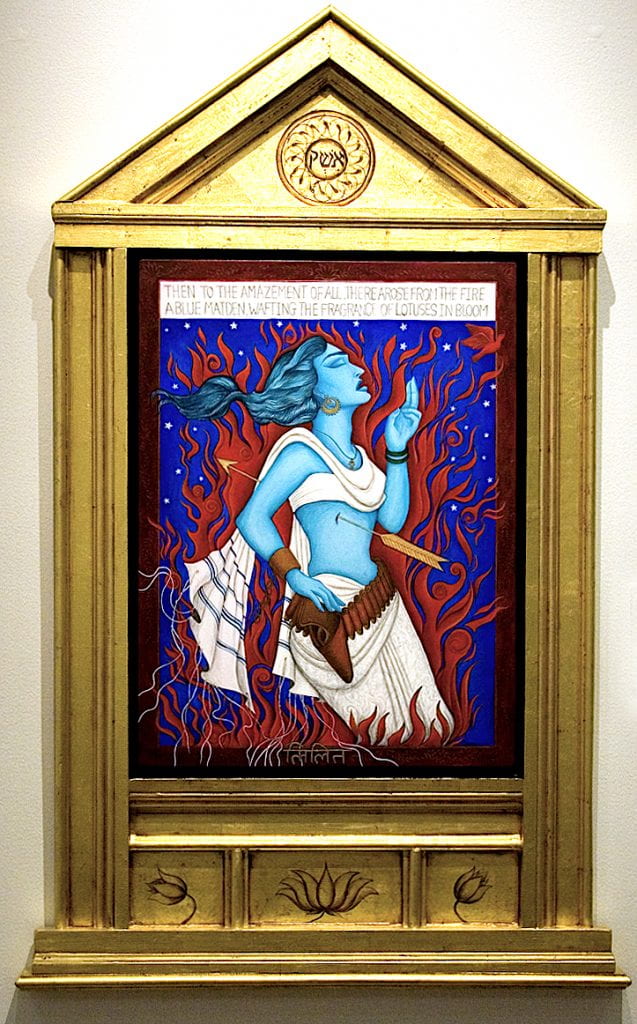
Finding Home #80 (Fereshteh) “Lilith” Gouache and 22K Gold Leaf on Panel
Gallery Talk on Weapons in Benjamin’s Work
Transcript
In Eddna Samuel (Akshikar), Siona Benjamin depicts nine of the same woman, Akshikar, standing in a circular manner, all connected at the foot, with the Star of David at the center. The image is replicated and refracted as if seen through symmetrically fractured glass. The focal point of the image is both the Star of David and its feminine guard. Importantly, Akshikar possesses bow and arrow pulled taut to her cheek, and each arrow is flying straight, outwards from both her and the Star of David. This woman is a protector of her Jewish heritage and faith. The piece also shows how she exists in a world influenced by Hinduism. This is most evident in both her traditional Indian dress and the bow and arrow imagery. Benjamin is also influenced Islamic tradition, Persian tradition, Jainist tradition, and other traditions on the diverse, and religiously plural, sub-continent. Two points of emphasis I will explore are the symbolic use of the bow and arrow in Jewish and Hindu contexts and the more general trend of weapons evident in Benjamin’s work.
The use of the bow and arrow has significant meaning in this work. As a member of the Bene Israel community, Benjamin’s subject is not only an inheritor of Jewish customs and tradition, but also Hindu customs and tradition. The references of the bow and arrow are numerous in the Hebrew Bible. For example, Psalms 21:11-12 shows how the bow is used defensively, against those wishing to destroy the Jewish community. Specifically, the psalm notes: “Though they plot evil against you and devise wicked schemes, they cannot succeed. You will make them turn their backs when you aim at them with drawn bow.”[1] Therefore, the bow and arrow is a weapon used in temporal realm by those within and outside of the Jewish community, but also by God, to smite the enemies of God’s people. In this vein, Akshikar is protecting her community, traditions, and customs, with a weapon suitable for God. Moreover, she is a woman, protecting things she holds dear, with a weapon that causes harm and even human fatality in a male-dominated world. Now, does this mean Akshikar will literally utilize violence to protect her traditions? Of course it is a possibility, but that is not the point. The symbolism of the bow and arrow used by the feminine guard, highlight the importance of women in the Bene Israel community. The women are just as, if not more important than, anyone in the preservation and defense of the faith. Certainly, Akshikar is embodying the commandment for the Jews to protect, shamor, and remember, zachor, the Sabbath and Jewish tradition.[2]
While this is just one look into the biblical tradition’s use of bow and arrow, it would be irresponsible to not pay good attention to the Hindu influence. The bow and arrow is also a mainstay in Hindu tradition – in iconography and classical narrative. The immediate reaction may link the bow and arrow use to the Bhagavad Gita. Arjuna famously utilizes the bow and arrow, with Krishna aiding him along.[3] Yet, this common connection is not the only instance of this weapon in Hindu tradition. Arjuna’s family, the Pandus, central to the Mahabharata, all use the bow and arrow. Rama, or Ram, a major god is also depicted wielding a bow and arrow, which was used in the famous battles.[4] And a goddess, Durga, also touts the bow in some art. She is seen wielding the long bow, shields, swords, maces, and even a trident.[5] She is a demon slayer – protector of what is good and destroyer of what is bad. In this sense, functionally, the bow and arrow are evoking matters of the cosmic. In these grand battles and founding stories, the bow and arrow are often the weapon of human or the divine, in the face of what is damaging to justness, order, and goodness. Here again, Benjamin is beautifully highlighting the cross-cultural influences of Judaism and Hinduism on the Bene Israel community. Whether the viewer links the weapon to the Hebrew Bible or the Mahabharata, Akshikar defends traditions she sees as vital to herself, her family, and her community. Moreover, she is able to defend those vital traditions in whatever setting or location. It does not matter if it’s New Jersey, Mumbai, the Midwest, or otherwise, the weapons of the gods and goddesses, along with their essence via religious symbols (Star of David in this case), aid in her defense.
While Akshikar promotes a positive association with the weapon, in other instances the bow and arrow possess a negative connotation. For instance, in her work Finding Home #80, an arrow pierces the belly of Lilith – posed in the style of Saint Sebastian, who was littered with arrows for betraying the Roman state, in order to aid Christians.[6] What this means may vary to the viewer, but what is certain, is that the bow and arrow was used to shoot Lilith. What does it mean that the bow and arrow that are traditionally used as a means of either war, defense, or food provision, and have normatively, but not absolutely,[7] been used by males in history? Moreover, what does it mean that these weapons are often depicted being used by gods? One way to interpret this is that a male-dominated, male-influenced, patriarchal society, has ultimately functioned to harm or repress the primary Lilith, and thus, all women or minority groups thereafter. For example, in India, the Hindu Nationalist party has utilized the bow and arrow to advance their politics. Specifically, Advani utilized Rama, the Ramayan narrative, and bow and arrow imagery, to spur support for the nationalist ideology, and justify tearing down of a historical mosque in favor of a temple to Rama.[8] Likewise, the bow and arrow imagery here, not the weapon that has been reclaimed by Akshikar, is emblematic of the past violent use of such a weapon, metaphorically or literally, against women – especially women with a strong sense of agency such as Lilith.
The bow and arrow are not the only weapons featured in Benjamin’s work. Weapons and representations of weapons also produce diverse interpretations of her work. That being said, the weapons do tend to continue to represent that dualism their use naturally produces – threat and repression or protection and defense. Weapons are evident in My America. Namely, there are two handguns, one pointed to the right and another pointed seemingly at Lilith who is looking towards the painting. Here, weapons of modernity may represent a continued violence against women, specifically transnational women in America. In other works, such as Finding Home #62 and Fereshtini #9, the women are shown brandishing swords. Finding Home #62 portrays Asnat with upright posture, one hand on her sabre and one hand holding a flower. Fereshtini #9 features a woman with angelic wings, sabre attached to the hip, holding a white bird in a cage with one hand, and letting one bird go with another. The ferocious looking lion is subdued by her tefillin. In these two works, the weapons are occupying the role as devices for protecting what is good, whether it is the flower or small bird.
Siona Benjamin’s use of both the bow and arrow and weapons more generally in her works, are fascinating. In Eddna Samuel (Akshikar), the bow and arrow is used by Akshikar to defend her traditions and customs – embodying Shamur Zachor. In Finding Home #80, the bow and arrow is shown in a way that pierces the abdomen of Lilith, representing metaphorical or literal violence done against Lilith, and thus all women and minority groups thereafter. Then, more broadly, Siona makes evident, weapons in other works such as My America, Finding Home #62, and Fereshtini #4. The handguns and sabers each offer a unique look at the dualistic trend of the nature of weapons – used for inherent good or inherent bad. That duality of these weapons is something ever present in the transnational identity and nuanced journey of Siona Benjamin, because in every place one thing is constant – violence exists in some form and most often against those marginalized. The weapons highlight this reality in both Benjamin’s world, and the world of her subjects, including those she captures in her works: Akshikar, Finding Home #80, My America, Finding Home #62, and Fereshtini #4.
Sources
[1] Book of Psalms. Psalms 21:11-12. NIV. https://www.biblegateway.com/passage/?search=Psalm+21&version=NIV (accessed 3/16/2022)
[2] MechonH.Sadmin. “Shamor and Zakhor.” Hadar.org, October 20, 2014. https://www.hadar.org/torah-resource/shamor-and-zakhor.
[3] Hill, Keith. “The Bhagavadgita: A New Poetic Translation.” The Bhagavadgita. Oxford University Press, 1953.
[4] Grover, Ruby. “Ancient Epic on Lord Rama.”
[5] Harle, James C. “Durgā, goddess of victory.” Artibus Asiae (1963): 237-246.
[6] Catholic Online. “St. Sebastian – Saints & Angels.” Catholic Online. Accessed April 4, 2022. https://www.catholic.org/saints/saint.php?saint_id=103.
[7] Dean, Rebecca Angharad, and M. Phil. “Women, weaponry and warfare.” Archaeology (2013).
[8] “’Mandir Wahin Banayenge’ Said L.K. Advani 30 Years Ago, but Will Stay Home on August 5.” The Wire. Accessed April 4, 2022. https://thewire.in/politics/lk-advani-ayodhya-bhoomi-pujan-ram-mandir-temple-rath-yatra.
